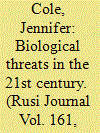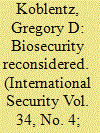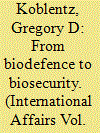|
|
|
Sort Order |
|
|
|
Items / Page
|
|
|
|
|
|
|
| Srl | Item |
| 1 |
ID:
148988


|
|
|
| 2 |
ID:
094414


|
|
|
|
|
| Publication |
2010.
|
| Summary/Abstract |
Advances in science and technology, the rise of globalization, the emergence of new diseases, and the changing nature of conflict have increased the risks posed by naturally occurring and man-made biological threats. A growing acceptance of a broader definition of security since the end of the Cold War has facilitated the rise of biosecurity issues on the international security agenda. Developing strategies to counter biological threats is complicated by the lack of agreement on the definition of biosecurity, the diverse range of biological threats, and competing perspectives on the most pressing biological threats. A comprehensive definition of biosecurity that encompasses naturally occurring, accidental, and deliberate disease outbreaks can help to further research, analysis, and policymaking. Operationalizing this broad conception of biosecurity requires a taxonomy of biological threats based on a levels-of-analysis approach that identifies which types of actors are potential sources of biological threats and the groups most at risk from these threats. A biosecurity taxonomy can provide a common framework for the multidisciplinary research and analysis necessary to assess and manage these risks. It also has implications for how to prevent and respond to biological threats, as well as for the future of biosecurity research.
|
|
|
|
|
|
|
|
|
|
|
|
|
|
|
|
| 3 |
ID:
111694


|
|
|
|
|
| Publication |
2012.
|
| Summary/Abstract |
The Seventh Review Conference of the Biological Weapons Convention (BWC), the first international treaty to outlaw an entire class of weapons, was held in Geneva in December 2011. On 7 December, Secretary of State Hillary Clinton became the highest-ranking US government official to address a BWC meeting. Secretary Clinton told the assembled delegation that 'we view the risk of bioweapons attack as both a serious national security challenge and a foreign policy priority'. At the same time, she warned that a large-scale disease outbreak 'could cripple an already fragile global economy'. Secretary Clinton's speech reflected a new understanding that the range of biological threats to international security has expanded from state-sponsored biological warfare programmes to include biological terrorism, dual-use research and naturally occurring infectious diseases such as pandemics. Recognizing these changes, President Barack Obama released a new national strategy for countering biological threats in 2009. This strategy represents a shift in thinking away from the George W. Bush administration's focus on biodefence, which emphasized preparing for and responding to biological weapon attacks, to the concept of biosecurity, which includes measures to prevent, prepare for and respond to naturally occurring and man-made biological threats. The Obama administration's biosecurity strategy seeks to reduce the global risk of naturally occurring and deliberate disease outbreaks through prevention, international cooperation, and maximizing synergies between health and security. The biosecurity strategy is closely aligned with the Obama administration's broader approach to foreign policy, which emphasizes the pragmatic use of smart power, multilateralism and engagement to further the national interest. This article describes the Obama administration's biosecurity strategy; highlights elements of continuity and change from the policies of the Bush administration; discusses how it fits into Obama's broader foreign policy agenda; and analyses critical issues that will have to be addressed in order to implement the strategy successfully.
|
|
|
|
|
|
|
|
|
|
|
|
|
|
|
|
|
|
|
|
|